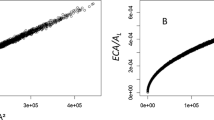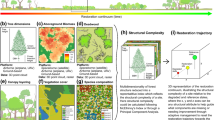Abstract
In this paper, we consider penetrating propagation of a plane monochromatic electromagnetic wave in woodlands where the concentration of randomly distributed forest elements is low. These elements lead to appearance of a randomly varying component in the effective complex permittivity of the forest. Assuming that the random perturbation of the refraction coefficient is small, we apply the Rytov approximation and find the normalized coherent and incoherent components of the electric field intensity at the receiving point.
Similar content being viewed by others
References
Popov, V.I., Radio Wave Propagation in Forests. NIR report no. 3566/3771, L’vov Polytechnical Intitute, The Chair in Theoretical Radio Engineering and Automatic Electrical Communications, 1981/1983.
Ishimary, A., Wave Propagation and Scattering in Random Media, NewYork: Academic Press, 1978, vol. 2.
Popov, V.I., Osnovy sotovoi svyazi standarta GSM (The basics of cellular communications in GSM standard), Moscow: Eco-Trends, 2005.
Author information
Authors and Affiliations
Corresponding author
Additional information
Original Russian Text © V.I. Popov, 2009, published in Avtomatika i Vychislitel’naya Tekhnika, 2009, No. 2, pp. 69–75.
About this article
Cite this article
Popov, V.I. Mathematical model for radiowave propagation in sparse forests: Rytov approximation. Aut. Conrol Comp. Sci. 43, 104–108 (2009). https://doi.org/10.3103/S0146411609020072
Received:
Published:
Issue Date:
DOI: https://doi.org/10.3103/S0146411609020072




